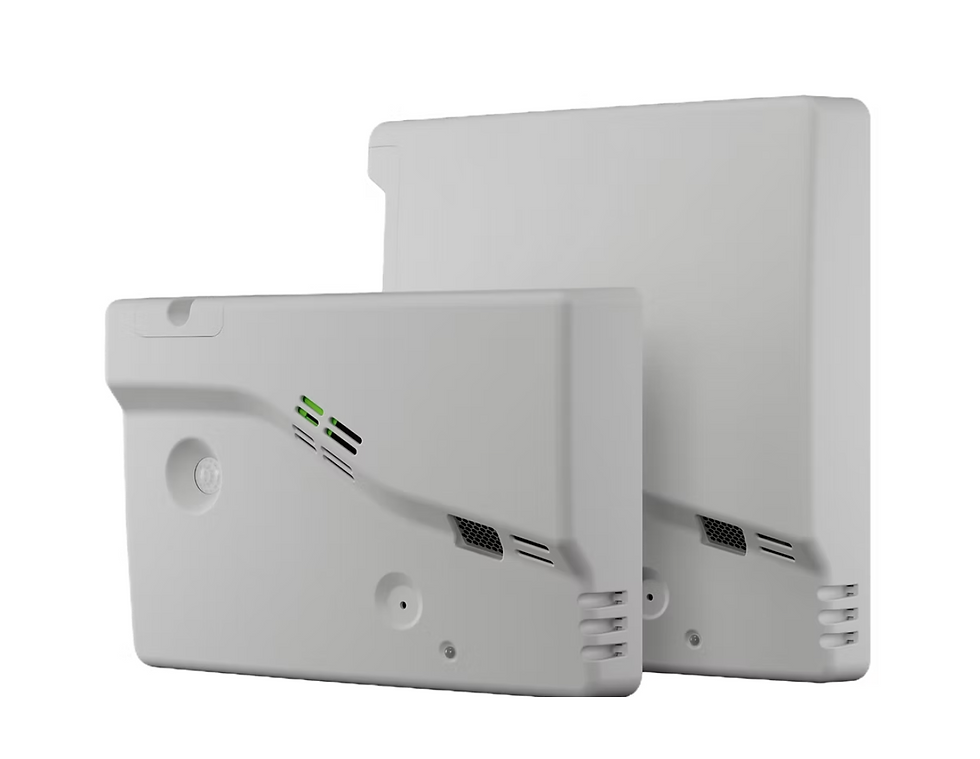Why Good Ventilation is Crucial This Winter to Help Prevent COVID-19
- Steve Milt
- Jan 10, 2021
- 4 min read
Updated: Sep 25, 2023
Key points:
Cases of COVID-19 continue to rise during these winter months as more people spend time inside and in close proximity to one another.
Effective ventilation of a space helps to prevent the recirculation of air containing the virus.
Air quality monitors are the best and most cost-effective way to assess indoor air ventilation.

With winter and chilling temperatures looming, the ability to bring fresh air into spaces becomes more challenging – yet, it remains more important than ever during the COVID-19 (coronavirus) pandemic.
As more people spend time inside during the cold-weather season, COVID-19 cases are steadily rising. And “we’re in for a whole lot of hurt,” said Dr. Anthony Fauci, director of the National Institute of Allergy and Infectious Diseases at the National Institutes of Health, in an interview with The Washington Post. “All the stars are aligned in the wrong place as you go into the fall and winter season, with people congregating at home indoors,” Fauci added. “You could not possibly be positioned more poorly.”
So, what can you do to protect others? Monitoring the air quality in your space to ensure good ventilation – especially in areas where people congregate – is crucial to help prevent COVID-19 transmission.
Why is monitoring your indoor ventilation important?
COVID-19 spreads through respiratory droplets made when an infected person coughs, sneezes, or talks. Indoor spaces are hot spots for transmission. That’s because COVID-19 droplets can stay in the air for minutes or hours – and travel tens of meters on air currents – depending on their size and weight. Appropriate ventilation of a space helps to push out virus-filled air from a room.
Areas where people are in close proximity – like schools – are among high-risk spaces for COVID-19 transmission. Schools, in particular, often have aging, poor ventilation systems, and some rooms may not have windows to bring fresh air into spaces. Students may be in close proximity to one another and also not consistently wear masks. All of these factors raise the risk of COVID-19.

How can schools optimally deploy resources to improve air ventilation?
Often faced with limited budgets, some schools may feel lost in identifying which of their spaces have good or bad ventilation and what to do about it. However, freezing the students and teachers in the classroom unnecessarily – or spending money to run Heating, Ventilation, and Air Conditioning (HVAC) systems more than is required – is also problematic. Air ventilation monitoring, such as with Zeptive’s first-of-its-kind portable sensor, is a cost-effective way to help shine a light on the current situation. It assesses key air quality measures, including:
Air changes per hour (ACH), which measures how quickly the air in a room is replaced with outdoor air.
Carbon dioxide (CO2) levels, which measure the amount of exhaled air in a space. In well-ventilated spaces, CO2 should stay below about 800-950 ppm to reduce COVID-19 infection risk.
Based on the results, school administrators can set forth the best plan to improve their space and monitor the air quality in the process.
What are other ways to reduce the risk of COVID-19 transmission indoors?

Consult with HVAC professionals: These professionals can inspect your ventilation systems to ensure they deliver clean air to your space and recommend improvements.
Avoid overcrowding: Because COVID-19 spreads through the air, it’s important to keep people at least six feet apart. Wearing masks reduces the transmission of respiratory droplets that contain virus, especially when social distancing is not possible.
Use other airborne infection control measures: The Centers for Disease Control and Prevention (CDC) and further research recommend using local exhaust, portable high-efficiency air filtration units and germicidal ultraviolet lights when upgrading or replacing existing HVAC systems is not possible.
By Kristin Barton, MA, CHES
Reviewed by Cindy Bistany, DHSc
References:
Bashir, M. F., Ma, B., Bilal, Komal, B., Bashir, M. A., Tan, D., & Bashir, M. (2020). Correlation between climate indicators and COVID-19 pandemic in New York, USA. The Science of the total environment, 728, 138835. Retrieved from https://www.ncbi.nlm.nih.gov/pmc/articles/PMC7195034/
Centers for Disease Control and Prevention. (2020, July 31). How to Protect Yourself & Others. Retrieved from https://www.cdc.gov/coronavirus/2019-ncov/prevent-getting-sick/prevention.html
Centers for Disease Control and Prevention. (2020, August 21). Operating schools during COVID-19: CDC’s Considerations. Retrieved from https://www.cdc.gov/coronavirus/2019-ncov/community/schools-childcare/schools.html
Centers for Disease Control and Prevention. (2020, October 5). Scientific Brief: SARS-CoV-2 and Potential Airborne Transmission. Retrieved from https://www.cdc.gov/coronavirus/2019-ncov/more/scientific-brief-sars-cov-2.html
The Washington Post (2020, November 02). 'A whole lot of hurt': Fauci warns of covid-19 surge, offers blunt assessment of Trump's response. Retrieved from https://www.washingtonpost.com/politics/fauci-covid-winter-forecast/2020/10/31/e3970eb0-1b8b-11eb-bb35-2dcfdab0a345_story.html
Cohn, M. (2020, September 11). Winter may bring a lot more coronavirus cases, new Johns Hopkins research finds. Retrieved from https://www.baltimoresun.com/coronavirus/bs-hs-hopkins-weather-covid-study-20200911-svxmklsp45ex3ieo6hxjcgpkj4-story.html
Galloway, H., & Salas, J. (2020, October 29). A room, a bar and a classroom: How the coronavirus is spread through the air. Retrieved from https://english.elpais.com/society/2020-10-28/a-room-a-bar-and-a-class-how-the-coronavirus-is-spread-through-the-air.html?ssm=TW_CC
Morawska, L., & Milton, D. K. (2020). It Is Time to Address Airborne Transmission of Coronavirus Disease 2019 (COVID-19). Clinical Infectious Diseases. doi:10.1093/cid/ciaa939 Retrieved from: https://academic.oup.com/cid/advance-article/doi/10.1093/cid/ciaa939/5867798
Morawska, L., Tang, J. W., Bahnfleth, W., Bluyssen, P. M., Boerstra, A., Buonanno, G., . . . Yao, M. (2020). How can airborne transmission of COVID-19 indoors be minimised? Environment International, 142, 105832. doi:10.1016/j.envint.2020.105832 Retrieved from: https://www.ncbi.nlm.nih.gov/pmc/articles/PMC7250761/
Prather, K. A., Marr, L. C., Schooley, R. T., Mcdiarmid, M. A., Wilson, M. E., & Milton, D. K. (2020). Airborne transmission of SARS-CoV-2. Science, 370(6514). doi:10.1126/science.abf0521 Retrieved from: https://science.sciencemag.org/content/370/6514/303.2
REHVA Federation of European Heating, Ventilation and Air Conditioning Associations. (2020, November 17). REHVA COVID 19 Guidance Version 4.0: How to Operate HVAC and Other Building Service Systems to Prevent the Spread of Coronavirus (SARS-CoV-2) Disease (COVID-19) in Workplaces. Retrieved from: https://www.rehva.eu/fileadmin/user_upload/REHVA_COVID-19_guidance_document_V4_23112020_V2.pdf
United States Environmental Protection Agency. (2020, November 04). Indoor Air and Coronavirus (COVID-19). Retrieved from https://www.epa.gov/coronavirus/indoor-air-and-coronavirus-covid-19



Comments